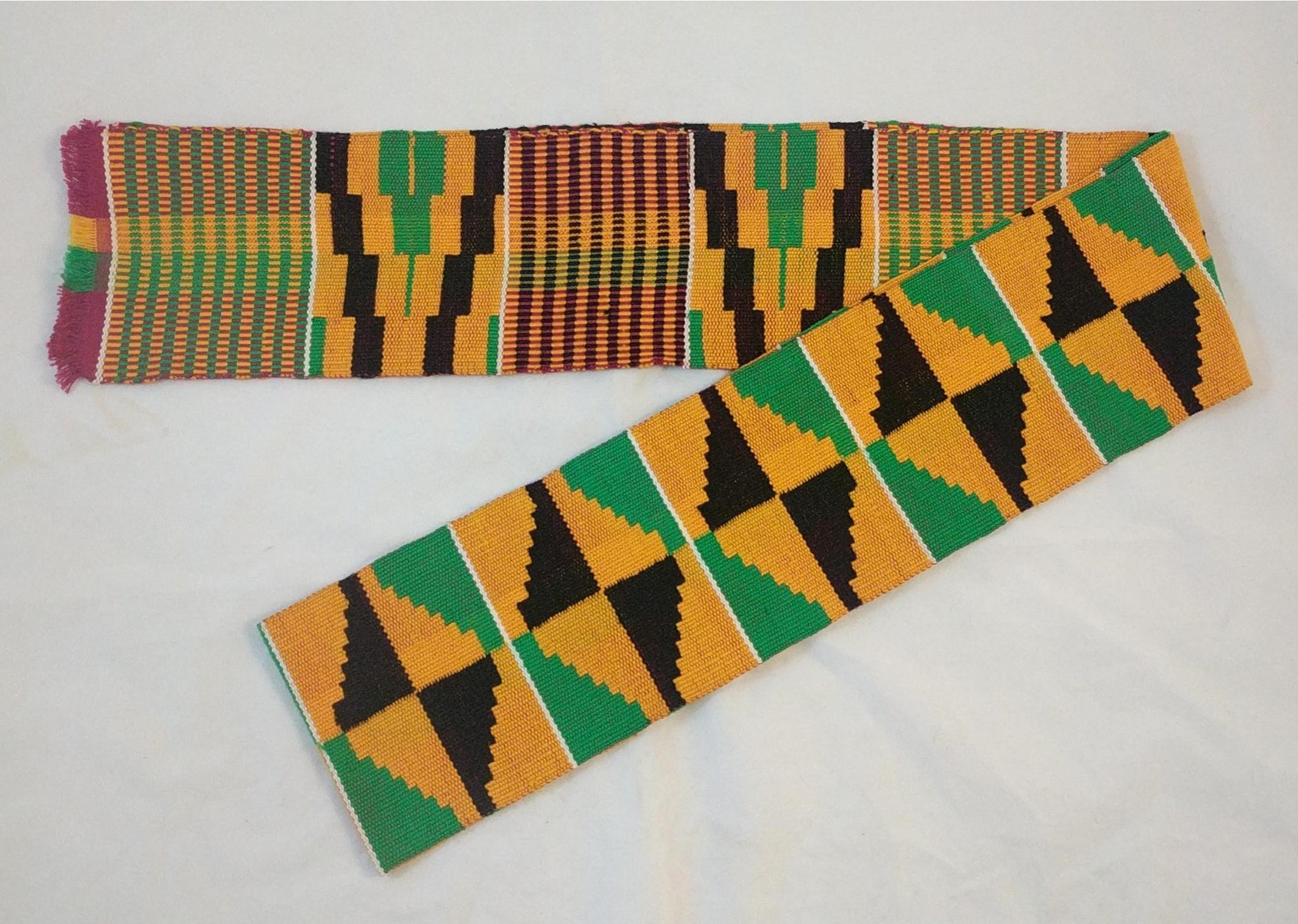As in most cultures, in African cultures, symbols of status are used to make distinctions among classes or other groups of people. The owners of status objects are recognized as powerful, wealthy, or high-ranking. In Africa, high-status individuals include people with hereditary power such as royalty; spiritual leaders; high-ranking military or civic leaders; prosperous individuals who bring wealth to the community; and elders in the community. Status symbols distinguish and honor these individuals, and in socially mobile communities, they also encourage people to excel and ascend the ranks of society.
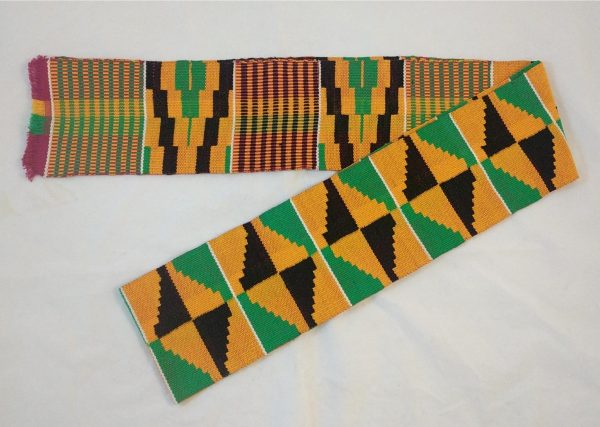
Asante culture
21st century
Cotton, silk, and pigments, L. 1.8 m x W. 11 cm x H. 1 mm
BFPC collection #2017.3
Traditional Kente cloths originally were restricted to royalty and the very wealthy. Kente was expensive because the different colors of dye used for the cloth were obtained only from rare wild plants. In addition, the intricate patterns are handwoven and require great skill and much labor to make. Kente cloth became more affordable when trade networks expanded, and access to new types of cotton, silk, rayon, and artificial dyes became widely available. Today, synthetic materials and even machine-printed imitation Kente allow virtually anyone to purchase and wear Kente or Kente-like cloth. Researched by Zoë Pixler

Benin culture (?)
19th century
Wood, metal, cowrie shells, leather, and string, L. 1.4 m x W. 12.3 cm x H. 5 cm
Stoneman collection #1985.88
Guns were introduced in the 18th century to Africa via trade networks with Europeans, first to the Benin and later to other African nations. These guns were not often used as a weapon, however, but for visual and auditory intimidation: The Benin’s enemies at the time, for example, believed that a sky god, allied with the King of Benin, was creating the thundering sounds made by the firing of the guns. The guns continued to be kept long after they were functional, as non-functional muskets like this one became symbols of high status and leadership. Researched by Zoë Pixler
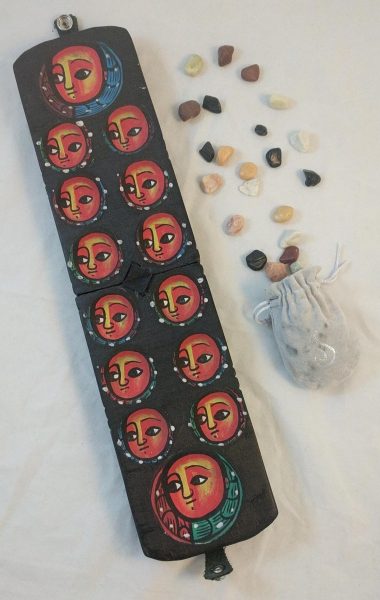
Ethiopian culture
21st century
Wood and pigments, L. 39 cm x W. 9.6 cm x H. 2.4 cm
BFPC collection #2017.10
Owning a mancala board does not indicate high status; rather, mastering the game of mancala is considered to be high status and sophisticated. Games in Africa are considered to be educational, as they are used to teach good values, skills, and the duties of a successful adult. Mancala games, for example, are used to teach planning and strategy.
There are many different versions of the game of Mancala, and the differences depend primarily on the number of holes in the game board. This mancala game is specifically a gabata board because it has two rows of six holes. The gabata board is the most popular mancala game, and it has been exported widely in the 21st century. Researched by Zoë Pixler

Dan culture
Mid-20th Century (before 1960)
Wood, pigment, and metal wire, L. 13.4 cm x W. 7 cm x H. 5.2 cm
BFPC collection #2016.8
In the traditional cultures of Africa, there is often a division of duties by gender, with some duties assigned only to men and some only to women. One duty for women is to show hospitality through preparing and hosting meals, and women strive to excel in this area. A great honor for women is to be selected to prepare a feast for the entire community during a masquerade celebration; the woman who is chosen to be the hostess is called the wunkirle, which is considered to be a very prestigious title.
Ladles or scoops such as the wake mia are presented to the wunkirle, and the ladle serves as a symbol that identifies her as both the most hospitable woman of the community and the most successful in cooking. At the beginning of the feast, the wunkirle has the privilege to lead a parade through the town, holding up the ladle that confirms her high status. Researched by Zoë Pixler
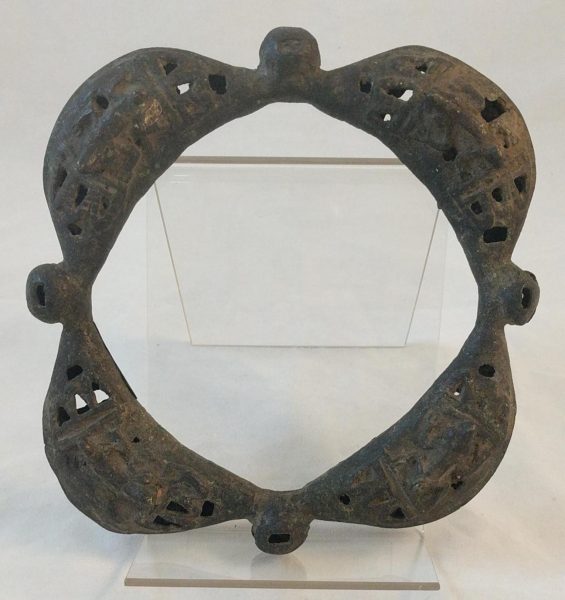
ca. 1835-1975
Cast brass filled with pebbles and beads, L. 17.3 cm x W. 17.3 cm x H. 2.9 cm
Mace collection #NN015a
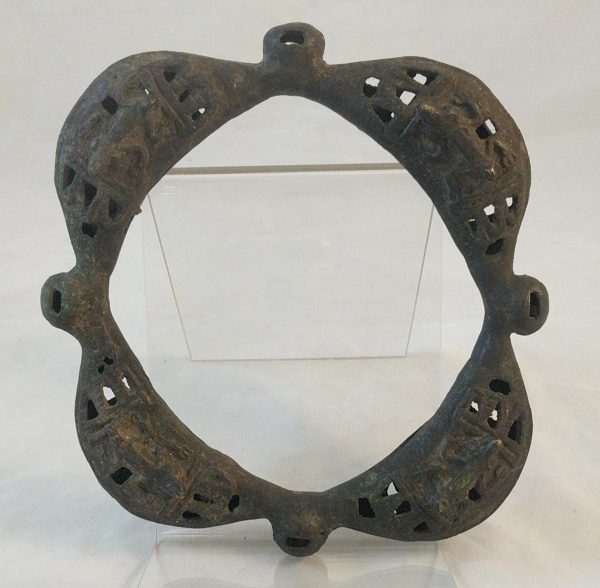
ca. 1835-1975
Cast brass filled with pebbles and beads, L. 17.3 cm x W. 17.3 cm x H. 2.9 cm
Mace collection #NN015b
The iku ankle rattle is a status symbol made by artisans of the Yoruba culture of Western Coastal Africa. The iku rattle is worn with costumes during rituals or ceremonies, such as the enthronement or funeral of a chief, and during masquerades, such as the festive Gelede masquerade to honor the Yoruba gods. The rattles provide rhythm for the music, and they also serve the function of scaring away any bad spirits with their loud noises. Members of the Ogboni secret society select the young men who will wear the iku rattles and dance at these events, and to be chosen is a great honor. Researched by Emily McClain and Zoë Pixler

Dan culture
20th century
Stained Wood, L. 10 cm x W. 5.9 cm x H. 44.5 cm
Stoneman collection #1985.7
The wunkirmian ceremonial ladle serves as symbol of status and honor for women who have been chosen as a wunkirle (also known as a wa ke de), a woman of the Dan culture who has achieved high status through her great hospitality. The presentation of the wunkirmian means that the woman has been chosen for the honor of being in charge of preparing and hosting the feast that accompanies the masquerades celebrating the planting season–because great hospitality is needed to properly celebrate the spirits honored in the masquerade. Before the feasts take place, the wunkirle holds the large wunkirmian ladle up as she leads a procession through the community, while rice and soup are distributed to the guests by her assistants. At the masquerade feast, the wunkirle hosts and feeds all of the guests, including the entertainers, the musicians, and the male agricultural workers of the community.
The wunkirmian is made in the form of a large serving ladle because it represents the hospitable act of serving others. The ladle form is also symbolic, as the deep bowl is often compared to a woman’s womb, honoring women as sources of life and sustenance. Researched by Emily McClain
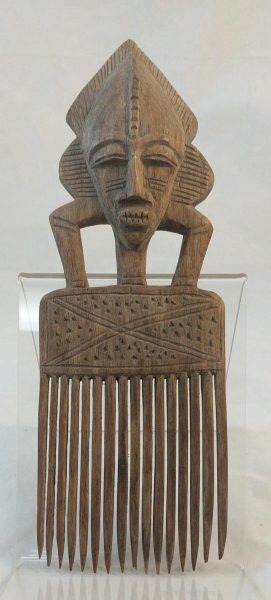
Senufo culture
20th century
Wood, L. 8.6 cm x W. 2.2 mm x H. 24.5 cm
BFPC collection #2011.50
Decorative hair combs or picks are popular among traditional cultures of Western Coastal Africa. The combs are usually carved from a relatively soft, light-colored wood, but they may also be made of bone, ivory, or metal. Carved wooden combs like this one are often given to adolescent girls from admirers, and men also carve them for their mothers or their girlfriends. The combs are thus a symbol of status indicating that a girl has come of age, and/or that a woman has an attentive boyfriend or son. Symbolic motifs are carved on the combs, and especially elaborate combs may have a figural handle; this comb is topped by a handle in the form of a Beautiful Lady mask, which identifies it as being made by a Senufo woodcarver. Researched by Emily McClain

Yoruba culture
21st century
Horse tail and leather, L. 9.5 cm x W. 5 cm x H. 75 cm
BFPC collection #2007.7
The irukere is a functional flywhisk made out of a horse’s tail, but it is also traditionally a symbol of high status and power among the Yoruba culture. The Yoruba king receives an irukere during his coronation ceremony. When the king sends an official message to summon his subjects, the irukere is often sent along with the messenger as a symbol of the king and his authority. While most closely associated with the king, the irukere may also be given to chiefs or priests as a symbol of praise or acknowledgement. Researched by Emily McClain
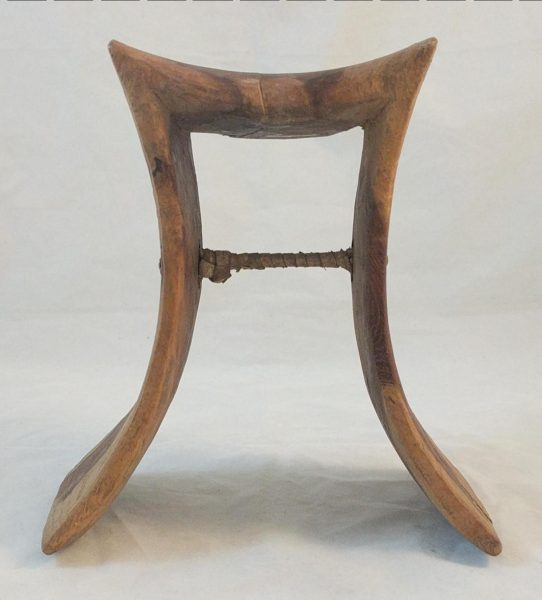
Karamojong culture
20th century
Wood, L. 18.5 cm x W. 9 cm x H. 19.8 cm
BFPC collection #2014.48
A head rest is a functional object used in many different African cultures to support the head during sleep, much like a pillow. There are many different shapes and styles of head rests, and this head rest most closely resembles those made by the Karamojong culture. The Karamojong make and use two different types of head rest; one is in the form of a capital pi symbol (Π) and the other, like this one, has the form of a lower-case pi symbol (π).
The Karamojong are nomadic pastoral people, so they will follow their herds and sleep on the ground to guard them. The head rest elevates the head to protect it from snake or scorpion bites during the night; sometimes the head rests are made purposefully unstable, so that the herder cannot completely fall asleep while watching the herd; these head rests symbolize vigilance. This head rest has been embellished with images of kudu, a type of antelope; as in most cultures that use head rests, Karamojong head rests that are carved and decorated also serve as status symbols and are displayed with pride. Researched by Emily McClain
For more information, you may contact the researcher(s) noted in the title of this exhibit entry, or Dr. Billie Follensbee, the professor of the course, at BillieFollensbee@MissouriState.edu

